The global in-mold labels market is valued at USD 2.8 billion in 2025 and is slated to reach USD 4.7 billion by 2035, recording an absolute increase of USD 1.9 billion over the forecast period. This translates into a total growth of 67.9%, with the market forecast to expand at a CAGR of 5.3% between 2025 and 2035. The market size is expected to grow by approximately 1.68X during the same period, supported by increasing demand for premium packaging solutions, expanding food and beverage industry applications, and rising adoption of efficient labeling technologies across consumer goods, automotive, and personal care applications.
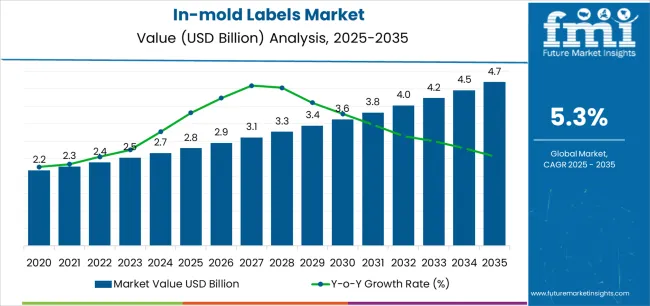
Between 2025 and 2030, the in-mold labels market is projected to expand from USD 2.8 billion to USD 3.6 billion, resulting in a value increase of USD 0.8 billion, which represents 42.1% of the total forecast growth for the decade. This phase of development will be shaped by increasing consumer preference for premium packaging aesthetics, rising adoption of automation in packaging processes, and growing demand for labels with enhanced durability and visual appeal. Packaging manufacturers are expanding their in-mold labeling capabilities to address the growing demand for food packaging applications, personal care containers, and automotive component labeling requirements.
| Metric | Value |
|---|---|
| Estimated Value in (2025E) | USD 2.8 billion |
| Forecast Value in (2035F) | USD 4.7 billion |
| Forecast CAGR (2025 to 2035) | 5.3% |
The packaging market contributes the largest share, accounting for approximately 35–40%, as IML technology is primarily used in packaging applications, including food and beverage, personal care, and consumer goods, offering high-quality graphics and durability. The plastic molding market adds around 25–30%, as IML is a critical component in injection and blow molding processes, where labels are integrated directly into the plastic products during manufacturing. This makes IML a key part of molded plastic product packaging.
The labeling market contributes about 15–18%, as IML is a prominent labeling solution in various industries due to its resistance to wear, moisture, and chemicals. It provides superior adhesion compared to traditional adhesive labels, making it ideal for products that need long-lasting, high-quality graphics. The consumer goods packaging market represents roughly 10–12%, as manufacturers seek innovative ways to enhance product appeal and differentiation through vibrant and durable labels. The food and beverage packaging market accounts for around 8–10%, as IML labels are widely used for food containers, bottles, and jars, where aesthetics, branding, and regulatory information play a key role in consumer purchasing decisions.
Market expansion is being supported by the increasing consumer demand for premium packaging aesthetics and the corresponding need for labeling solutions that can provide exceptional visual appeal, integrated application processes, and durability features while enabling cost-effective production and supporting brand differentiation strategies across food and beverage, personal care, and household products packaging operations. Modern brand owners and packaging manufacturers are increasingly focused on implementing labeling solutions that can improve packaging appearance, reduce production steps, and provide consistent performance throughout complex manufacturing and distribution networks. In-mold labels' proven ability to deliver exceptional visual quality, enable integrated manufacturing processes, and support cost-effective production make them essential components for contemporary packaging solutions and brand presentation strategies.
The growing emphasis on packaging efficiency and brand differentiation is driving demand for in-mold labels that can support integrated production requirements, improve manufacturing efficiency, and enable distinctive packaging designs. Brand owners' preference for labels that combine visual appeal with production efficiency and processing compatibility is creating opportunities for innovative in-mold labeling implementations. The rising influence of e-commerce packaging requirements and premium product positioning is also contributing to increased demand for in-mold labels that can provide enhanced durability, visual impact, and integration with automated packaging systems across diverse market applications.
The in-mold labels market is poised for robust growth and evolution. As brand owners, packaging manufacturers, and consumer goods companies seek labels that deliver exceptional visual appeal, production efficiency, and manufacturing integration, in-mold labels are gaining prominence not just as decorative elements but as strategic enablers of efficient packaging systems and brand communication.
Rising consumer preference for premium packaging in developing regions and expanding food processing industry globally amplify demand, while manufacturers are leveraging innovations in printing technology, smart labeling systems, and advanced material formulations.
Pathways like digital printing integration, enhanced barrier properties, and application-specific material configurations promise strong adoption rates, especially in high-growth segments. Geographic expansion and brand partnership development will capture volume, particularly where local manufacturing capabilities and packaging industry proximity are critical. Regulatory pressures around food safety requirements, packaging efficiency standards, recycling compatibility, and quality compliance give structural support.
The market is segmented by technology type, material type, end-use industry, printing technique, and region. By technology type, the market is divided into Injection Molding, Blow Molding, and Thermoforming. By material type, it covers Polypropylene (PP), Polyethylene (PE), PET, and others (PVC, PS). By end-use industry, it includes Food & Beverages, Personal Care & Cosmetics, Automotive, Household Products, and others. By printing technique, it is categorized into Flexographic, Digital, Gravure, and Screen Printing. Regionally, the market is divided into North America, Europe, Asia Pacific, Latin America, and Middle East & Africa.
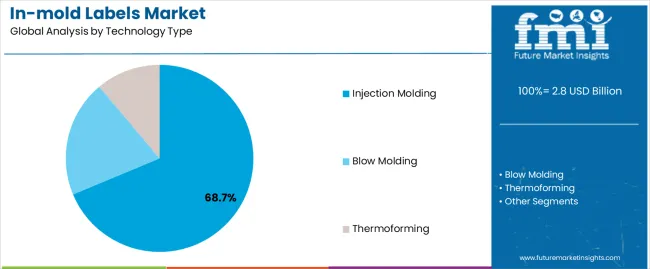
The injection molding segment is projected to account for 68.7% of the in-mold labels market in 2025, reaffirming its position as the dominant technology category. Brand owners and packaging manufacturers increasingly utilize injection molding in-mold labels for their optimal combination of production efficiency, dimensional accuracy, and cost-effectiveness characteristics, making them ideal for high-volume consumer goods applications. The injection molding technology's established industry acceptance and proven performance directly address the operational requirements for reliable label integration in diverse product categories and manufacturing environments.
This technology segment forms the foundation of modern packaging operations, as it represents the process with the greatest market penetration and established demand across food and beverage, personal care, and household products applications. Manufacturer investments in advanced injection molding equipment and process optimization continue to strengthen adoption among brand owners and packaging companies. With organizations prioritizing production efficiency and cost effectiveness, injection molding in-mold labels align with both performance requirements and budget constraints, making them the central component of comprehensive packaging strategies.
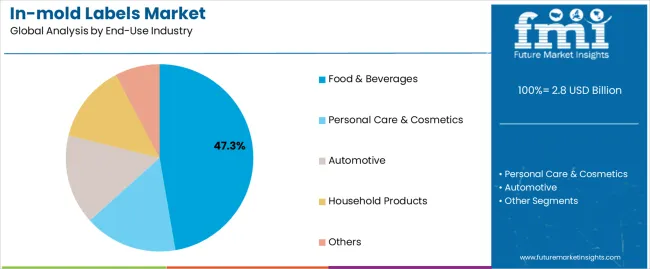
Food & Beverages applications are projected to represent 47.3% of in-mold labels utilization in 2025, underscoring their critical role as the primary market for delivering labels to dairy products, ready meals, beverage containers, and food packaging applications through integrated production processes. Food manufacturers prefer in-mold labels for their ability to provide food-safe decoration, moisture resistance, and visual appeal while ensuring regulatory compliance with packaging standards. Positioned as essential components for premium food packaging, in-mold labels offer both aesthetic advantages and functional performance benefits.
The segment is supported by continuous innovation in food-safe materials and the growing availability of customized label designs that enable brand differentiation with enhanced visual impact and regulatory compliance features. Food manufacturers are establishing long-term supply partnerships to support consistent in-mold label procurement and packaging standardization. As premium food packaging becomes more prevalent and brand differentiation increases, Food & Beverages applications will continue to dominate the market landscape while supporting comprehensive packaging solutions and consumer appeal strategies.
The in-mold labels market is advancing rapidly due to increasing consumer preference for premium packaging and growing adoption of efficient labeling solutions that provide superior visual appeal, integrated production processes, and cost-effectiveness while enabling streamlined manufacturing across food and beverage, personal care, and consumer goods applications. The market faces challenges, including high initial equipment costs, technical complexity in production setup, and the need for specialized expertise across different application requirements. Innovation in digital printing technologies and advanced material formulations continues to influence product development and market expansion patterns.
The growing adoption of digital printing systems, variable data capabilities, and short-run production technologies is enabling manufacturers to produce in-mold labels with superior customization options, enhanced visual quality, and flexible production functionalities. Advanced printing systems provide improved color accuracy while allowing more efficient job changeovers and real-time quality monitoring across various packaging operations and brand applications. Packaging manufacturers are increasingly recognizing the operational advantages of digital printing capabilities for customization optimization and production flexibility.
Modern in-mold label producers are incorporating high-performance films, specialized adhesive systems, and enhanced barrier properties to improve functional performance, enable extended shelf life, and deliver value-added solutions to quality-conscious brand owners and packaging manufacturers. These material innovations improve product protection while enabling new market opportunities, including premium packaging applications, technical component labeling, and specialized performance requirements. Advanced material integration also allows manufacturers to support brand differentiation goals and regulatory compliance beyond traditional labeling functionality.
| Country | CAGR (2025-2035) |
|---|---|
| China | 7.4% |
| India | 8.1% |
| USA | 4.7% |
| Germany | 4.2% |
| Brazil | 6.3% |
| Japan | 3.9% |
| France | 4.5% |
The in-mold labels market is experiencing varied growth globally, with India leading at an 8.1% CAGR through 2035, driven by the expanding consumer goods industry, growing food processing sector development, and significant investment in packaging infrastructure modernization. China follows at 7.4%, supported by rapid manufacturing expansion, increasing premium packaging adoption, and growing brand differentiation initiatives. The USA shows growth at 4.7%, emphasizing automation adoption and premium packaging trends. Germany demonstrates 4.2% growth, prioritizing packaging innovation and advanced manufacturing technologies. Brazil records 6.3%, focusing on consumer goods expansion and growing organized retail. Japan exhibits 3.9% growth, emphasizing quality standards and technical applications. France shows 4.5% growth, supported by luxury goods packaging and food industry development.
The report covers an in-depth analysis of 40+ countries, with top-performing countries are highlighted below.
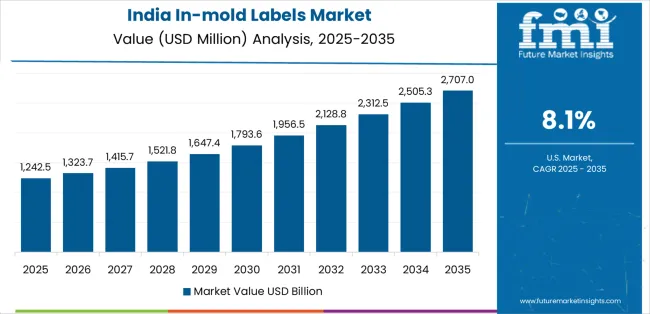
Revenue from in-mold labels in India is projected to exhibit exceptional growth with a CAGR of 8.1% through 2035, driven by expanding consumer goods industry and rapidly growing food processing sector supported by rising disposable incomes promoting premium packaging adoption. The country's strong position in manufacturing development and increasing investment in modern packaging technologies are creating substantial demand for in-mold labeling solutions. Major consumer goods companies and packaging manufacturers are establishing comprehensive labeling programs to serve both domestic market requirements and developing export opportunities.
Demand for in-mold labels in China is expanding at a CAGR of 7.4%, supported by the country's massive manufacturing base, expanding premium packaging requirements, and increasing adoption of advanced labeling technologies. The country's industrial capabilities and growing consumer market are driving requirements for comprehensive labeling solutions. International suppliers and domestic manufacturers are establishing extensive production and distribution capabilities to address the growing demand for in-mold labeling products.
Revenue from in-mold labels in the USA is growing at a CAGR of 4.7%, supported by the country's established packaging industry, strong emphasis on production efficiency, and robust demand for premium packaging solutions in consumer goods and food processing applications. The nation's advanced manufacturing infrastructure and innovation-focused operations are driving sophisticated in-mold labeling systems throughout the production network. Leading manufacturers and technology providers are investing extensively in automation capabilities and advanced printing technologies to serve both domestic and international markets.
Demand for in-mold labels in Germany is anticipated to expand at a CAGR of 4.2%, driven by the country's advanced manufacturing standards, innovative packaging technologies, and commitment to quality excellence. Germany's technical expertise and precision focus are supporting demand for in-mold labels in automotive applications, technical components, and premium consumer goods. Manufacturers are establishing comprehensive quality systems to serve the demanding domestic market and European export opportunities.
Revenue from in-mold labels in Brazil is expected to grow at a CAGR of 6.3%, supported by the country's growing consumer goods industry, expanding food processing sector, and increasing investment in modern packaging infrastructure. Brazil's large domestic market and commitment to industrial modernization are supporting demand for in-mold labeling solutions across multiple consumer segments. Manufacturers are establishing comprehensive production capabilities to serve the growing domestic market and regional opportunities.
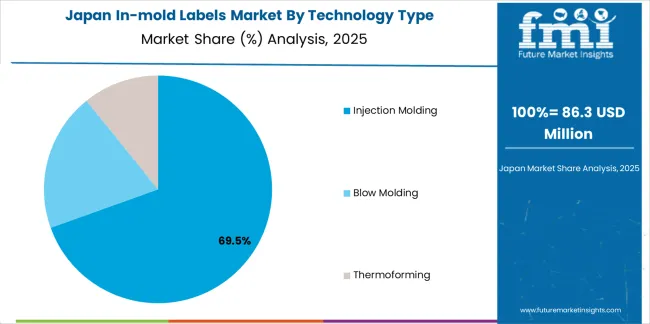
Demand for in-mold labels in Japan is forecasted to expand at a CAGR of 3.9%, driven by the country's established manufacturing excellence, emphasis on quality standards, and strong position in technical applications. Japan's precision manufacturing capabilities and commitment to innovation are supporting investment in advanced labeling technologies throughout major industrial segments. Industry leaders are establishing comprehensive technical capabilities to serve automotive, electronics, and premium consumer goods applications.
Revenue from in-mold labels in France is growing at a CAGR of 4.5%, supported by the country's luxury goods industry, growing food processing sector, and strategic position in European markets. France's established premium brands and integrated manufacturing infrastructure are driving demand for high-quality in-mold labels in cosmetics, food packaging, and luxury applications. Leading manufacturers are investing in specialized capabilities to serve premium market requirements and quality standards.
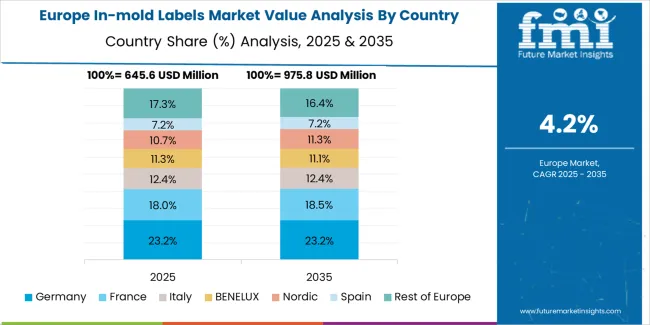
The in-mold labels market in Europe is projected to grow from USD 0.9 billion in 2025 to USD 1.4 billion by 2035, registering a CAGR of 4.6% over the forecast period. Germany is expected to maintain its leadership position with a 28.7% market share in 2025, adjusting to 29.2% by 2035, supported by its strong packaging industry infrastructure, advanced manufacturing capabilities, and comprehensive automotive applications serving diverse in-mold labeling requirements across Europe.
France follows with a 19.5% share in 2025, projected to reach 20.1% by 2035, driven by robust demand for in-mold labels in luxury goods packaging, food processing applications, and cosmetics industries, combined with established manufacturing infrastructure and quality-focused production capabilities. The United Kingdom holds a 16.2% share in 2025, expected to reach 16.8% by 2035, supported by strong consumer goods manufacturing and growing premium packaging adoption. Italy commands a 14.3% share in 2025, projected to reach 14.7% by 2035, while Spain accounts for 9.1% in 2025, expected to reach 9.4% by 2035. Netherlands maintains a 4.8% share in 2025, growing to 5.0% by 2035. The Rest of Europe region, including Nordic countries, Eastern Europe, Belgium, Austria, and other nations, is anticipated to maintain momentum, with its collective share adjusting from 7.4% to 4.8% by 2035, attributed to increasing packaging industry development in Eastern Europe and growing premium goods manufacturing in Nordic countries implementing advanced labeling systems.
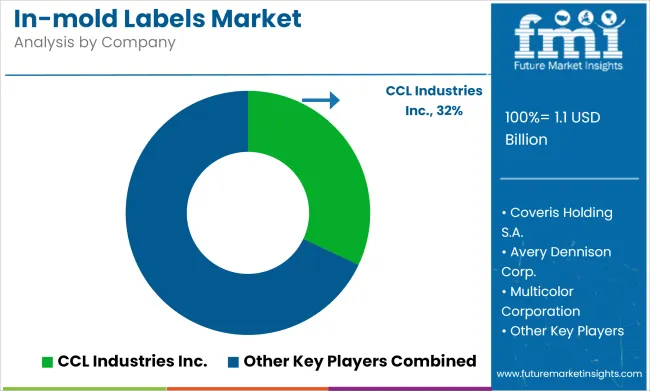
The in-mold labels market is characterized by competition among established label manufacturers, specialized printing companies, and integrated packaging solutions providers. Companies are investing in printing technology research, material development optimization, automation integration, and comprehensive product portfolios to deliver consistent, high-quality, and application-specific in-mold labeling solutions. Innovation in digital printing capabilities, advanced material formulations, and production automation is central to strengthening market position and competitive advantage.
Multi-Color Corporation leads the market with strong global presence, offering comprehensive in-mold labeling solutions with a focus on food and beverage applications. CCL Industries provides specialized manufacturing capabilities with an emphasis on premium decoration and advanced printing technologies. Constantia Flexibles delivers innovative labeling products with a focus on barrier performance and global distribution networks. Huhtamaki Group specializes in comprehensive food packaging solutions and integrated labeling programs. Coveris Holdings focuses on high-quality manufacturing and diverse application capabilities. Fort Dearborn Company offers specialized labels for consumer goods with emphasis on digital printing compatibility.
| Items | Values |
|---|---|
| Quantitative Units (2025) | USD 2.8 billion |
| Technology Type | Injection Molding, Blow Molding, Thermoforming |
| Material Type | Polypropylene (PP), Polyethylene (PE), PET, Others (PVC, PS) |
| End-Use Industry | Food & Beverages, Personal Care & Cosmetics, Automotive, Household Products, Others |
| Printing Technique | Flexographic, Digital, Gravure, Screen Printing |
| Regions Covered | North America, Europe, Asia Pacific, Latin America, Middle East & Africa |
| Countries Covered | United States, Canada, United Kingdom, Germany, France, China, Japan, India, Brazil, Australia and 40+ countries |
| Key Companies Profiled | Multi-Color Corporation, CCL Industries, Constantia Flexibles, Huhtamaki Group, Coveris Holdings, and Fort Dearborn Company |
| Additional Attributes | Dollar sales by technology type and material category, regional demand trends, competitive landscape, technological advancements in digital printing systems, advanced material development, automation compatibility, and brand partnership integration |
The global in-mold labels market is estimated to be valued at USD 2.8 billion in 2025.
The market size for the in-mold labels market is projected to reach USD 4.7 billion by 2035.
The in-mold labels market is expected to grow at a 5.3% CAGR between 2025 and 2035.
The key product types in in-mold labels market are injection molding , blow molding and thermoforming.
In terms of end-use industry, food & beverages segment to command 47.3% share in the in-mold labels market in 2025.






Full Research Suite comprises of:
Market outlook & trends analysis
Interviews & case studies
Strategic recommendations
Vendor profiles & capabilities analysis
5-year forecasts
8 regions and 60+ country-level data splits
Market segment data splits
12 months of continuous data updates
DELIVERED AS:
PDF EXCEL ONLINE
Competitive Landscape of In-Mold Labels Providers
USA In-mold Labels Market Insights – Demand, Innovations & Growth 2025-2035
ASEAN In-mold Labels Market Report – Size, Growth & Outlook 2025-2035
Japan In-mold Labels Market Trends – Growth, Size & Forecast 2025-2035
Germany In-mold Labels Market Report – Size, Demand & Growth 2025-2035
Latin America In-mold Labels Market Size and Share Forecast Outlook 2025 to 2035
Labels Market Analysis - Size, Share, and Forecast Outlook 2025 to 2035
Labels, Tapes And Films Market Size and Share Forecast Outlook 2025 to 2035
Competitive Overview of Labels Companies
USA Labels Market Size and Share Forecast Outlook 2025 to 2035
Market Share Distribution Among USA Labels Providers
Foam Labels Market Trends and Growth 2035
Market Share Breakdown of Foil Labels Manufacturers
Foil Labels Market Analysis by Metal Foils & Polymer-Based Foils Through 2035
Kraft Labels Market Size and Share Forecast Outlook 2025 to 2035
HAZMAT Labels Market Growth and Forecast 2025 to 2035
Printed Labels Market Size and Share Forecast Outlook 2025 to 2035
Sheeted Labels Market Size and Share Forecast Outlook 2025 to 2035
QR Code Labels Market Size and Share Forecast Outlook 2025 to 2035
Braille Labels Market Size and Share Forecast Outlook 2025 to 2035

Thank you!
You will receive an email from our Business Development Manager. Please be sure to check your SPAM/JUNK folder too.
Chat With
MaRIA